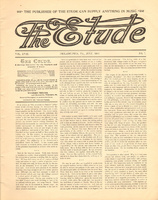Many have been the attempts and numerous the failures to introduce congregational singing in our churches. The desire to have the congregation do the singing arises, sometimes, from a conviction that it most agrees with the idea of public worship, and sometimes from a determination to reduce the running expenses of the establishment. It not infrequently happens that the officiary of the church, being seized with a spasm of economy, first turn their attention to the choir, and in their zeal to lessen expenses decide to dispense with its services altogether, hire a precentor with great capacity of lung and prodigious volume of voice, and, standing him on the platform beside the preacher, say to the congregation: “Now, sing.” And, while congratulating themselves that they have thus inaugurated congregational singing, the trouble begins. The minister finds himself limited in the selection of hymns to those only of a common meter, and the precentor to such tunes only as are familiar. The constant repetition of the same tunes, however pleasing at first, like the continuous wearing of the same apparel, however fine, becomes monotonous. Not only is “Variety the spice of life,” but very essential in the public exercises of divine worship. The most eloquent sermon becomes ineffective by repetition. The eye wearies of the same scene; the taste of the same food; the nostrils of the same aroma; the ear of the same song; every sense rebels against a continuousness of the same thing. Even the verdure of the fields and the luxuriant foliage of summer will pale and die under the continuous rays of an August sun. Rain and sunshine, dewy night, and midday heat are indispensable to fruits and flowers. And the nature of man demands variety no less than the growths of the natural world. Awakened to this fact —this law, by the spiritless singing of the congregation, it is attempted to revive their sluggish worship, by the introduction of hymn- and tune- books, or, these being already in use, resort is made to “Gospel Hymns” or some publication akin to them as being more simple and “catchy,” seemingly oblivious to the fact that nine-tenths of the congregation cannot tell one note from another, and cannot and will not sing until they have learned the tune by ear; so that in the endeavor to introduce the new tunes the precentor is generally obliged to sing them alone accompanied by the organ and perhaps a few straggling voices here and there in the audience, until, becoming discouraged, he either resigns his position or resumes the use of the old familiar tunes. Nothing kills congregational singing so quickly or destroys musical worship so effectually as to turn the service into a singing school. And yet congregational singing can be made a success in almost any church. The two prime essentials are an efficient organist and a competent precentor, or, we should say, a director, a person able not only to sing, but to instruct and train a chorus-choir, and not afraid of work: a veritable and untiring enthusiast. Then all the singing material available, old and young, male and female, should be organized into a class, with meetings at least once a week for instruction and practice. You might as well hope to erect a substantial edifice without a foundation as to expect success in congregational singing without organization and systematic training and practice. It is just as necessary that the precentor prepare his music as that the minister prepare his sermon for the Sabbath service. Your organization completed and the hymns selected by the minister for the following Sabbath thoroughly rehearsed, your singers may be utilized for the purpose of congregational singing in several ways:
1. Where the organ is situated, back of or at the side of the pulpit, and the space allotted to the choir will permit of it, the singers may be massed and, beside leading the congregation in singing the ordinary selections for the occasion, the director will be enabled to lend variety to the service by the rendering of suitable anthems, sentences, chants, and so forth.
2. The singers may be distributed among the audience, and the director act as precentor from the pulpit platform. In this case the singing on all occasions would be confined to the hymn- and tune- books.
3. These two methods may be combined, a certain number of singers being formed into a choir, and the others distributed through the congregation. Where twenty-five or more singers can be gathered into an organization this last is by far the best way of utilizing them for congregational singing. Even with a choir of fifty voices to lead, the congregation will sing with timidity and hesitation, while one strong voice in a pew will inspire those around him to sing with spirit and heartiness. People are like a shepherd’s flock in that if one leaps the barrier the rest are sure to follow. Courage, confidence, is contagious. A congregation fully convinced that it is expected and desired of them to unite their voices with the choir in swelling the songs of praise in the sanctuary will heartily respond. The failure of congregational singing where it has been attempted has resulted from mismanagement oftener than from anything else. The people love to sing and will sing if encouraged to do so.—Rev. C. O. Hanmer.



